THE SAI MOVEMENT IN LATIN AMERICA
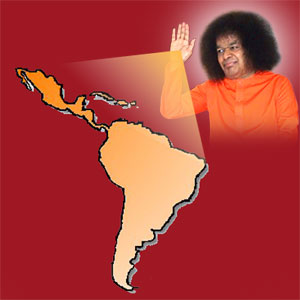 Starting this issue, Heart2Heart is pleased to present a series of articles on Sai in Latin America. There is hardly anyone who does not know about America but when it comes to Latin America, amazingly there are many who hardly know about its existence. And yet, in this part of the world that many do know about, there is a very strong Sai presence. Way back in 1992, late Dr. John Hislop noted that the spirit of Sai was sweeping Latin America like wild fire. He explained that this was because Latin America was almost 100 % Catholic and that Catholics accept saints and mysticism quite easily.
Starting this issue, Heart2Heart is pleased to present a series of articles on Sai in Latin America. There is hardly anyone who does not know about America but when it comes to Latin America, amazingly there are many who hardly know about its existence. And yet, in this part of the world that many do know about, there is a very strong Sai presence. Way back in 1992, late Dr. John Hislop noted that the spirit of Sai was sweeping Latin America like wild fire. He explained that this was because Latin America was almost 100 % Catholic and that Catholics accept saints and mysticism quite easily. In the years that have followed, the Sai movement in Latin America has grown enormously, and it is quite moving to see large numbers of people coming to Prashanti Nilayam all the way from countries like Guatemala, Ecuador, Columbia and so on, countries that many here have not even heard of. A devotee from Madras (now Chennai) who recently went to Brazil to transact some business, went to a city in the middle of the country and checked into a hotel. As he did so, he was stunned to see a huge picture of Swami in the lobby! He was simply knocked out. Who would imagine seeing a picture of Swami in a hotel in Brazil, and that too in a humdrum city in the interior? That is the Glory of the Avatar that has its own magical way of spreading - unknown to most people.
H2H takes great pleasure in presenting this series, in the hope that the spirit of the people of Latin America in spreading the Message of Baba would be a source of inspiration for all of us. Particular thanks are due to John Behner of El Salvador and Leonardo Gutter of Argentina, both of whom have been of invaluable help to us in producing this series. In passing, we might also mention, that with the help of devotees from Latin America, Radio Sai has been able to broadcast regularly, services in Spanish and Portuguese. Imagine that! Swami’s Discourses, Bhajans etc., in these languages filling the airwaves. Who would have thought that such things would be possible even as late as 2000? But miracles keep happening all the time. Welcome to the Sai world in Latin America!
We begin with a lead article by Leonardo Gutter on Latin America in general. This is followed by an article by John Behner on Sai’s presence in Mexico.
AN INTRODUCTION TO LATIN AMERICA
By Leonardo Gutter
By Leonardo Gutter
Loosely speaking, Latin America is that part of the continent of America, that lies to the south of the United States. In a more strict sense, the term Latin America is supposed to stand for all the countries that were once colonies of Spain, Portugal and France. Since Spanish, Portuguese and French were all derived from Latin, the term Latin America generally designates nations that were once the colonies in the New World of these European powers.
In geographical terms, the American continent may be considered to be made up of three parts: North America, South America and Central America. North and South America are linked by Central America, which at one point becomes very narrow.
Latin America as presently understood, comprises of 23 countries. They are: Mexico, Guatemala, Belize, El Salvador, Honduras, Nicaragua, Costa Rica, Panama, Cuba, Jamaica, Haiti, Dominican Republic, Puerto Rico, Venezuela, Colombia, Ecuador, Peru, Bolivia, Argentina, Uruguay, Paraguay, Brazi , and the Guayanas. We begin with a description of the region known as Central America .
CENTRAL AMERICA
GENERAL CHARACTERISTICS
This region comprises of Mexico, the countries that lie below Mexico right down to Panama, and the Caribbean islands. Many volcanoes crisscross the region from the West to the East. The climate of Central America is generally warm, though in the hilly regions it tends to be mild and pleasant. Baring Cuba and Puerto Rico where the population is predominantly white, in all other countries the population is mixed, with some being white, some black, some of Indian origin [not from India!] and the rest racially mixed. The official language in most countries is Spanish - Brazil of course being a major exception, where the official language is Portuguese. However, many other languages and dialects are also spoken, especially where the indigenous population is predominant. | 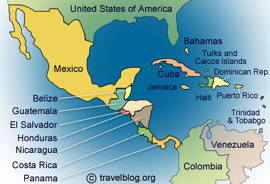 |
There is also considerable diversity in the economic levels of the different segments of the population, with many of them being quite poor.
Mexico:
 | Mexico lies just south of the United States, and has the shape of a horn. It is washed by the Pacific on the western side and the Atlantic on the eastern side. The land slopes sharply on the Pacific coast while the slope is gentler on the Atlantic side. The capital city is Mexico City, which is at quite a height above sea level. It is also densely populated. The other big cities are: Guadalajara, and Monterrey . The official language is Spanish. There is no official religion; however, Catholics form the majority. Thanks to the fertile soil, agriculture is widespread, the crops raised ranging from corn, wheat and rice, all the way to sugarcane, coffee and cocoa. There are also many industries. Mexico also produces oil, fifty percent of which is exported to the United States. | |
Mexico City - an aerial view |
Guatemala: Guatemala is a very mountainous country, with land elevation varying quite substantially across the country. As a result, there is a considerable variation in the climate, the upper regions being cold and the lower regions being warm. The population is quite mixed racially, with people of indigenous origin being in majority. Most of the people are Catholics. The official language is Spanish, and the Capital is Guatemala City. The country is predominantly agricultural, and not very rich. Sugar cane and bananas form the main export items. |  | |
A Guatemala mountain |
 | Belize: This is a small country located on the south east of the Yucatan Peninsula, having Mexico, and Guatemala as neighbours. There are rich tropical forests near the coast and pine forests in the interior. Thanks to the moderating influence of the sea, the climate is not as warm as it otherwise might have been. The population is mostly indigenous and of African origin. The country is poor and the economy depends mainly on forest products. The capital is Belmopan. | |
Rich forest in Belize |
El Salvador:
El Salvador is flanked by the Pacific, Guatemala and Honduras. The country is mountainous and there are many volcanoes. It is also prone to earthquakes. The rivers are not very long and of torrential character with many cascades as they flow to the ocean.
 |  | |
A cathedral in Santa Ana | One of the many volcanoes in El Salvador |
The Capital city is San Salvador and the other big cities include San Vicente, Holy Ann and Sansonate. Spanish is the official language and the people are predominantly Roman Catholics. The bulk of the population is mostly racially mixed and also poor. Coffee, corn, cotton and sugar constitute some of the major agricultural products; besides that, there is also some mining of gold, silver, copper and iron. Almost all the minerals are exported.
 | Honduras: Honduras is a small country tucked between the Caribbean Sea in the north and the Pacific in the south, besides flanked by Guatemala, Nicaragua and El Salvador. The country is quite mountainous and receives a lot of rain. The capital is Tegucigalpa,and the population is mostly made up of people of mixed racial origin. A large part of the country is covered by forests with cedar, mahogany, and oak. Agriculture is the main occupation. | |
Friends in Honduras... |
Nicaragua:
Nicaragua too is like most of the central American republics, mountainous with many volcanoes, sandwiched between the Pacific and the Atlantic, generally poor, and is ethnically diverse. There are some valuable mineral deposits also. The capital is Managua, and the official language is Spanish.
 |  | |
A child in Nicaragua | Banana - an important product in Costa Rica |
Costa Rica:
Another small country, very similar to many others in the region but with a more humid and tropical climate compared to the countries to the north of it. Like most central American countries, banana is an important agricultural product. The Capital is San Jose and the official language is Spanish.
Panama:
 | Though a tiny country, Panama is probably better known than most of its northern neighbours on account of the famous Panama canal. Here, the huge and expansive American continent shrinks to a mere 65 km or so. No wonder, the man-made canal linking the Atlantic and the Pacific is located here. On account of being an important maritime highway, Panama naturally has a very cosmopolitan population. Spanish naturally is the official language but English is quite well understood. There is of course agriculture, mining etc., but the Panama Canal is unquestionably the country’s greatest “industry”. | |
The Panama Canal |
Haiti:
Haiti is truly an interesting country. It forms the western part of a Caribbean island close to Cuba. Historically, it used to be a French colony but the black slaves rose in rebellion and drove the French out over two hundred years ago. Thus Haiti not only became independent a long time ago, but also a French-speaking “black” republic! As is to be expected, the official language is French, another factor that makes Haiti unique. The capital is Port au Prince and the dominant religion is Catholicism. Dominican Republic: This country occupies the eastern part of the island of which Haiti forms the other part. Historically, the Spanish ruled this part of the island, hence Dominican Republic. Though similar to Haiti in terms of topography, landscape, climate etc., it has a rather different cultural tradition and of course language, which is Spanish. The population is made up largely of people of mixed racial origin. | 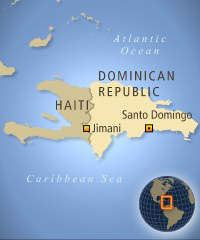 |
SOUTH AMERICA
GENERAL CHARACTERISTICS
The land mass normally described as South America is not only huge but also quite distinctive in many ways. First, there are the tall mountains that run right through, almost close to the Pacific coast. To the east of the Andes mountains, the land slopes towards the Atlantic, providing a nice route for the many rivers rising in the Andes, the famous Amazon being of course the biggest of them all – indeed, the Amazon can rightfully claim to be the biggest river in the whole world. The climate is predominantly tropical, and the principal racial groups are the native Indians, the blacks, the whites and people of mixed racial origin. The countries that make up South America include: Venezuela, Columbia, Bolivia, Ecuador, Peru, Paraguay, Chile, Uruguay, and of course the big ones, namely, Brazil and Argentina. Spanish is the official language everywhere, except in Brazil, where it is Portuguese, for well-known historical reasons. We now offer a thumb-nail picture of the countries in the region. | 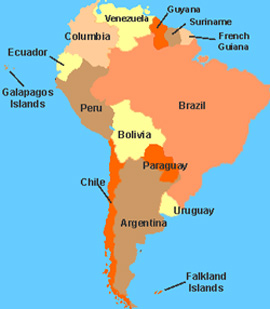 |
 | Venezuela: Venezuela is to the north east of the South American landmass, and flanks the Atlantic Ocean. It is partly mountainous, and has many lakes. The population is substantially of mixed racial origin, with a small minority of whites and black people. The capital is Caracas, the language is Spanish, and most of the people are Roman Catholics. Oil is the important produce and there is some agriculture as well. | |
Caracas - The capital of Venezuela |
Colombia: The Republic of Colombia is placed between the Atlantic Ocean and the Pacific Ocean, bordering Panama, Venezuela, Brazil, Peru and Ecuador. The soil of Colombia is characterized by its immense variety. The Andes dominate the western region, and the Amazon has its origin there. The capital is Bogota. As elsewhere, Spanish is the official language and the population is mostly of mixed racial origin. Coffee is the most important product. The country is also rich in many minerals. |  | |
Coffee picking in Colombia |
Ecuador:
 | Ecuador is a small country with the Pacific to the west, Columbia to the north and Peru to the south. The equator crosses through Ecuador. There are many volcanoes. The capital city is Quito. Guayaquil is another important city. The population is quite mixed, being composed of native Indians, white, black and people of mixed races. Spanish is the official language. The country is, like many in the region, quite poor. Perhaps, Ecuador is most famous for the Galapagos islands that belong to it. These islands lie in the Pacific more than a 1000 km away from the mainland, and this is where Charles Darwin made many crucial observations that later led him to formulate his famous Theory of Evolution. The country has some oil and a lot of mineral resources. However, they are yet to be exploited vigorously. | |
The Galapagos islands of Equador |
Peru: Peru is one of the important countries in the southern hemisphere, with a substantial land mass. It shares with Bolivia its neighbour on the south east, the famous Titicaca lake. Its western region is very mountainous with snow-capped peaks but to the east there are rich forests. The capital is Lima, and the official language is Spanish. Roughly 46% of the population is made up of native Indians, besides which there are, as elsewhere in the continent, the usual quota of whites, blacks and people of mixed racial origin. In addition, there are also many Chinese and Japanese immigrants. |  | |
The Natives of Peru... |
 | Bolivia: This country named after the famous freedom fighter Simon Bolivar, is landlocked, being surrounded by Peru, Chile, Brazil , Argentina, and Paraguay. There are some mountains. Part of the country is a plateau, and part of it a plain. More than half the population is made up of native Indians, while the rest is made up of the usual mix, including whites and blacks. The constitutional capital is Sucre while the government works from the city of La Paz . The official language is Spanish but the use of native Indian languages is widespread. Mining is the main industry. | |
Tropical forest in Bolivia |
Chile:
Chile is a country with a unique shape, a long narrow strip enveloping the Andes, bordering the Pacific Ocean, and stretching right down to a point facing the Antarctic continent. The capital is Santiago and the population is almost exclusively white. The official language is Spanish.
 |  | |
A church in Santiago, Chile's capital | Native Indians in Paraguay |
Paraguay:
Paraguay is yet another landlocked country, tucked between, Brazil, Bolivia and Argentina. It is relatively flat and semi-arid, with two big rivers running across. The climate is warm and dry. The Tropic of Capricorn runs through this country. Paraguayans are primarily native Indians, especially of the Guarani tribe. The Capital is Asuncion. The country has two languages, Spanish and Guarani. The economy is essentially agricultural.
Brazil:
 |  | |
Spice garden in Brazil | Rio de Janeiro - a famous city of Brazil |
Brazil is truly huge, with most of the South American rivers that drain into the Atlantic, passing through it, the Amazon being of course the biggest of them all. There are numerous lakes in the country. The climate is varied, being equatorial in some regions, tropical in some places and subtropical in others. The population is predominantly white, but there is a sizeable population of blacks and people of mixed racial origin. In marked contrast to the other countries in the region, Portuguese is the official language. Brasilia is the capital, though Rio de Janeiro is probably better known. Agriculture no doubt forms an important segment of the economy, but Brazil is industrially quite advanced in many sectors. In this respect, it stands out compared to many other Latin American countries.
Uruguay: Uruguay flanks the Atlantic coast, with Brazil and Argentina as its neighbours. The river Uruguay separates the country from Argentina. The terrain is marked by gentle hills making the landscape slightly wavy. The population is made up mostly of immigrants from Spain and Italy. The official language is Spanish, and dominant religion is Catholicism. |  | |
A park square in Uruguay |
Argentina:
Argentina is also a big country, the western part being mountainous, the eastern part being flat and the region in between being a plateau. The population is predominantly white. The official language is Spanish although in the interior where native Indians live, Indian dialects are also spoken. The capital is Buenos Aires, and the people are substantially Catholic. Agriculture is an important occupation. The country also produces some oil. It has big reserves of iron ore and natural gas.
 |  | |
An Argentinian farmer | A catholic church in Buenos Aires |
The above is meant to be a general introduction to Latin America. As can be seen, this part of the world was opened up mainly by the Spanish and the Portuguese, and to a smaller extent by the French. Culturally, ethnically and economically and in many other ways, Latin America is very different from USA and Canada .
In terms of the Sai movement, there are two important factors worth noting. Firstly, unlike Hislop who played a key role in the Sai movement taking roots in USA , one cannot identify one central figure associated where Latin America is concerned. Secondly, unlike in USA and Canada, there is hardly any Asian Indian population in Latin America . Thus the character and the growth of the Sai movement in Latin America has a unique character of its own, and one can clearly see Swami guiding the growth in His own special way.
In this the first article on Sai activities in Latin America, we have John Behner telling us about what is happening in Mexico. He is starting with Mexico not for geographical reasons, but because the Sai movement in Latin America took hold there first.
MEXICO, THE BIRTHPLACE OF THE SAI ORGANIZATION
IN LATIN AMERICA
IN LATIN AMERICA
By John Behner
A Brief Overview of Mexico
Mexico has contributed to the culture and spiritual development of man from ancient times. Several thousand years ago, pyramids to the sun and the moon were built at Teotihuacan, which means the City of the Gods. These pyramids were built by the Toltecs and are comparable in size to the pyramids in Egypt. Teotihuacan is a spiritual center, which includes many other pyramids and ceremonial buildings.
 |  | |
A Mayan Indian spinner | A pyramid in Teotihuacan, a spiritual centre |
At about the same time, the Mayan Indians were developing a very advanced culture further south. They knew the sun’s magnetic cycles and the secrets of life and the universe. Their science was of a very high order and they were able to explain how the sun affects life on earth such as the earth’s weather, seasons, and even ages which can be correlated to the yugas described in the Upanishads.
They knew the purpose of life and death, the journey of the soul which can return to the creator purified or diminished, returning to earth later for another try at purification through suffering. After the Spanish invaded Mexico and destroyed the Aztec Empire in 1519 AD, the Mayan and Toltec cultures declined.
Mexicans became a mixed race, part Indian and part Spanish. The people are generally easy going and love music and dance. Unlike their neighbours to the north (the Americans), Mexicans are not so time conscious. They open their shops late, and also stay open late. Lunch is the big meal of the day, followed by a siesta. Corn, beans and rice are the staples of their diet, and yes the Mexicans like spicy food, just as the people in India do. Another parallel in the diet is tortillas, similar to the chapattis, but made with corn. Modern Mexico is known for its modern architectural designs, and there are many beautiful buildings. Mexicans have great devotion for Virgin Mary. Way back in the late 1500s, Virgin Mary appeared to a poor Indian peasant named Juan Diego, in a region that is now Mexico City. At the hill where she appeared, a famous shrine has been built as she requested, and she is worshipped as the Lady of Guadalupe. People from all over the world frequent the shrine as many miraculous cures are taking place there. |  | |
Lady of Guadalupe in Mexico City |
The population of Mexico is about a hundred million, and 25 % of that lives in Mexico City the capital. With this overview we would like to describe how the Sai movement became established in Mexico.
How the Sai Organisation Took Root in Mexico
 |  |
In 1973, Dr. Luis Muniz and his wife, Gail traveled to India from Mexico with the idea of visiting some spiritual masters for whom they had references. Their program included visits to six ashrams. The last site scheduled, and one that looked less interesting to them, was the Ashram of Sathya Sai Baba. For various reasons, visits to the other five ashrams had to be dropped; in some cases the Guru was not available, or he was away. So they arrived at the Ashram of Sai Baba. Their plan was to stay for there for only seven days as they were to continue visiting the other Ashrams. Instead of seven days, they stayed on for seven weeks! Amazed by the miraculous Sai Baba and His wisdom, their doubts instantly vanished. Sai Baba talked to them about their lives in such a detailed manner, that they were very moved.
One night Gail had an unusual dream and at 3:00 AM woke her husband to tell him about it. Three days later, Baba called them for an interview, and with a smile said to her: “Three nights ago you had a dream didn’t you?” Then addressing Dr. Muniz, He said “and she woke you up at three o’clock in the morning to tell it to you, isn’t that so?” In the interview they asked Swami if they could open a Sai Center, though they didn’t have the faintest idea how to do it. Baba gave them very simple guidelines, “Women should sit on one side and men on the other. There should be a good aroma.”
The Growth of the Sai Organization
 | Back in Mexico City, at first it was a family affair. Later, other devotees joined. They followed Swami’s instructions and transmitted it to others. Then other people started singing bhajans in their homes, not only in Mexico City but in other cities as well. In such a simple way, the seed of the Sai Organization was planted in Latin America. There are now 29 Sai centers in Mexico and over 250 centers in Latin America. From the very beginning, Swami allowed Dr Muniz to publish Sai literature in Spanish. Arlette Meyer from Venezuela translated Howard Murphet’s book, “Man of Miracles” into Spanish, and gave it to Dr. Muniz. This was the first book to be published in Spanish. Later Swami authorized Dr. Muniz to publish Sanathana Sarathi in Spanish. Now there are over 200 books about Swami, and by Swami in Spanish. As the Sai Centers grew, so also did the activities of the three wings of the Organisation. They are now making a positive contribution to the communities and uplifting the members in their spiritual growth. Three Sai mothers from Ciudad Cuauhtemoc in the state of Chihuahua, went to the school that their children were attending and asked to be allowed to give Sathya Sai Human Values Classes. Their proposal was accepted and that small start resulted in 128 schools in the state of Chihuahua both public and private, asking for the program over the next ten years. |
The Institute of Human Values Comes Into Being
An Institute of Human Values was formed and over 1500 teachers have been trained. One teacher commented that before becoming involved with the Sathya Sai Human Values program, she felt exploited by the State, that her profession as a teacher was the worst profession in the world, and she always wanted to go on strike. Now she says her pay is when a little girl comes up and embraces her, and says, “I wish you were my mother”. |  |
 | 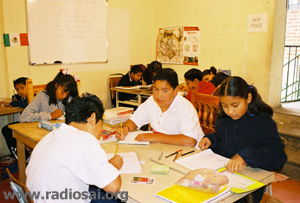 | |
Inside Sai Schools of Mexico ... | ||
As the program in teaching and spreading human values grew, it became apparent that an ideal school was needed to demonstrate what this program can really do for the children. With this objective, two Sai Schools have been opened, one in Chihuahua and the other in Cuernavaca. There are about 100 children in each school.
 |  | |
At the Sai School in Chihuahua... | ||
Here is an example of how the values are impacting these children occurred at the Chihuahua school. One day during recess; the 2nd grade children were strangely quiet. The teacher went to the window to see what was happening and saw all the children sitting in a circle meditating. After a minute or two, one of the children got up and moved to another spot in the circle and sat down and continued to meditate. A minute later another child changed places. After about 20 minutes the children came in from their recess. The teacher asked what they had been doing. The answer was: “meditating”. Then she asked why they were moving to different places in the circle. The answer: “to hear God better”.
Another incident shows how the children teach the teachers, and also their parents. One little boy was crying and so the teacher took him outside to talk to him and try to cheer him up. There was a mandarin tree in the neighbor’s yard which had a branch which came over into the school yard. The teacher asked the boy if he would like a mandarin. Between his tears, he said, “I thought you said it was wrong to take things that do not belong to us”.
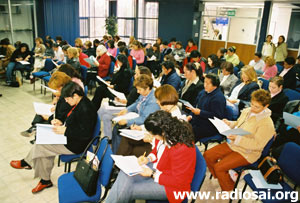 |  | |
Diploma course in Human Values by Sathya Sai Institute of Human Values, Mexico | ||
The Sathya Sai Institute of Human Values is training public and private school teachers in diploma courses that last 90 hours. One teacher said that, “this program must really work”, because since taking it and practising the values, she has started to enjoy teaching and can feel the love of the children. Up in the sierra, the training course was taken to a village where there had been several teens who had committed suicide. The application of the program in the village school has helped to overcome this terrible situation.
The Government’s Encouraging Support for the Noble Work
In both Chihuahua and Tijuana, the education authorities have recognized this program of Sathya Sai Human Values as extremely valuable. In Chihuahua the Ministry of Education paid for the printing of teacher’s manuals containing the Sathya Sai EHV program, and in Tijuana, the municipal education authorities have put a Sai devotee in charge of the Sai EHV program at all the public schools. In the city of Monterrey, where a large public school has requested the program, after 3 years, a neighbor wrote a note to the principal telling him that she used to be afraid of walking in front of the school, but now she is happy that the school is her neighbor. In the beginning, one classroom at the school was painted black, and had grafitti on the walls. Now the school is clean and painted in pastel colors. The children are proud of their school thanks to Sathya Sai EHV. |  | |
At the Sai School in Cuernavaca |
Amazing Transformation In Teens
Service programs have been numerous and varied. In Monterrey, at a correctional Institution for youth, devotees are giving human values classes to the youth and to their parents. On Mondays, ladies from the Sai center give classes to the girls section and on Tuesday, the men give classes to the boys. These youth are from ages 12 to 17. This has brought about a big change in their behavior.
On Fridays, the devotees meet with the parents. This is an interactive meeting and once the parents start to tell of their problems with drugs, liquor, theft etc. all of them start to open up and they find support and love in the group, especially from the devotees. Their attitude toward their children has changed radically and they are starting to develop a loving relationship with their siblings. This has changed the parent’s behavior and many of them have a history of being in and out of jails for one thing or another. These people are changing for the better, getting jobs, and keeping them. Some have stopped drinking and using drugs. The Governor of the State has given a certificate of recognition to the Sai Organization for the wonderful work they are doing at this detention center.
Reaching Out to the Underprivileged...
In Mexico City in a slum area, devotees are showing the residents how to prepare soy protein, which is given to them by the government. In another shanty town, a medical clinic has been established and is open 6 days a week.
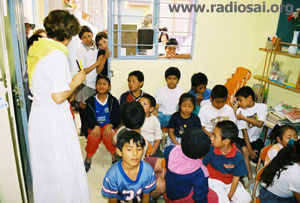 | 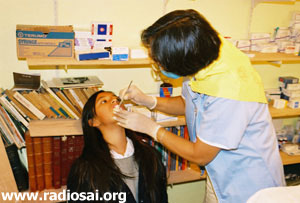 |
Medical Clinic for the young and hygiene lessons by Mexican Sai Volunteers
 |  |
One man who was an alcoholic received so much love from the devotees working at the clinic that he stopped drinking, found a job, and is now supporting his mother. Another man came to the clinic after his wife told him about the loving attention she received in pre-natal care run by Sai devotees. He was a drug addict, but has been able to kick the habit and maintain a job to support his wife and their new-born son. After a major earthquake in Mexico City, Sai Seva Dals rushed to establish 2 soup kitchens which served hot meals to rescue workers and people who had been left homeless for many days.
Moving Hearts with Devotional Singing In the devotional wing, there are bhajans that are sung in Spanish at most centers. Some are outstanding. The Tijuana centers have recorded a CD with their songs and at the Tuxtla Gutierrez center, the devotees were asked to sing at a municipal program which lasted for two days. The first day they gave the Sai Organization 15 minutes of program time. After they heard them sing, the next day they gave them 4 hours. Thousands of people heard their devotional singing. |  | |
A devotional singing session in progress.. |
Mysterious Blessing During a Public Meeting in Mexico City
We have also held many public meetings in Mexico, the most outstanding was a meeting in Mexico City. The meeting was to start at 11 AM on a Sunday morning in a well known auditorium. There were about 1200 people present when one of the volunteers who was helping outside in front of the theater came in and advised the people at the back of the theater to go outside and see the sun. People started to walk outside, and look up at the sun. Inside, the people who were on stage did not know what was happening. But then they too were advised to go outside. Over a thousand people were looking up at the sun. A few were taking pictures. It was a beautiful day with a clear blue sky, and a bright orange ring had formed around the sun. This was Swami’s Darshan, because it was a very unusual phenomenon.
 |  | |
The mysterious vision of the Sun just before the public meeting started... | ||
The next day the major newspapers of Mexico carried photos and scientific explanations, which were pretty far out. It was apparent the scientists didn’t know what was happening, but the devotees did.
Sarvadharma - Bringing All Religions Together These public meetings are bringing new people to the centers; most are interested and buy a book and learn more about Sai Baba. The Sai Centers are making their ceremonies and altars look more ecumenical and using study circles to help introduce Swami’s message to newcomers and old timers alike by incorporating them into the regular bhajan meetings. |  |
Furthering His Mission in a Myraid Ways….
 |  | |
Beach cleaning in progress by Mexican Sai Youth | A Sai Volunteer serving in another unique way... |
The youth of Mexico are very active in forming groups and looking for difficult service activities. In Veracruz, a group of youth have been doing a beach cleaning service which no one wanted to do, not even the authorities. Other youth have dedicated themselves to establish electronic web information such as Sai Bhajans, and discourses, and a site for Sathya Sai EHV. Mexico will continue to lead the way for many to find the Avatar in this historic moment of time.
We, at Heart2Heart, wish all the Sai devotees of Mexico the very best and pray for Sai’s choicest blessings on them to carry on the wonderful work that they are continuously engaged in.
- Heart2Heart Team.
<Next>























